Triumph of Spring (Fortune: Evolution Game): Difference between revisions
1d4chan>FortuneBro |
1d4chan>FortuneBro |
||
| Line 213: | Line 213: | ||
===Skullroot, Deathmasque=== | ===Skullroot, Deathmasque=== | ||
[[File:Deathmasque_00.png|200px|thumb|A Proboscis Scorpion infected with a Deathmasque.]] | [[File:Deathmasque_00.png|200px|thumb|A Proboscis Scorpion infected with a Deathmasque.]] | ||
(Description to be added at a later date. | (Description to be added at a later date.) | ||
===Snow Beetle=== | ===Snow Beetle=== | ||
Revision as of 01:33, 15 May 2012
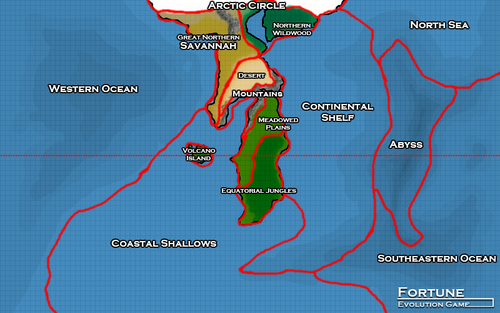
The Triumph of Spring is the name given to the fifth part of the Fortune: Evolution Game. It is set after the end of the Ice Age that comprised parts 3 & 4. The name was first used here on 1d4chan, and was discovered by the players in the midst of Discussion Thread 2. Triumph of Spring introduced a new map, with a variety of environments and a reworked continent (shifted by continental drift etc.). It also introduced a new landmass, called Volcano Island, formed as a result of the massive eruption that led to the end of the Ice Age.
This article/entry is for additional details and fluff concerning the starting organisms available at the very start of the thread, along with behind the scenes information about the creation and development of the species by FortuneHost and the players.
Animals
Aquabeast

The Aquabeast is a carnivorous aquatic repto-mammal that lives in cold saltwater habitats, usually inhabiting the mid-range to deep ocean depths. It makes its home in the Continental Shelf and the North Sea Regions.
The Aquabeast is about the size of a whale shark, roaming the mid to near-surface depths of the ocean. While most of its body is covered in dense bony armor, its underbelly is adorned with slick blue hairs, stuck close together, similar to a penguin's feathers. Being such a large beast, this creature's digestive system is wonderfully efficient, even the bones of prey are digested. The calcium present in these goes to the upkeep/growth of the Aquabeast's impressive armor (which, is actually a modified second skeleton). While the Aquabeast is only moderately fast, it does have the advantage of a long tongue, one that can extend it body length away. In this regard, the Aquabeast has changed little from its Spineback predecessor, it remains an ambush predator, relying on a single decisive strike to grab prey before it has a chance to react.
Arctic Serpent

The Arctic Serpent is an arboreal mammal whose main diet consists of insects and prefers forests with a cold to temperate climate. They are found in the region known as the Northern Wildwood.
The Arctic Serpent is one of Fortune's few mammals, giving live birth and with lactating females. While their ancestors burrowed underground to escape the cold, since the meltdown, they have returned to their arboreal routs, hanging in the boughs of trees in groups of up to a dozen. Here they eat the many insects that are (suprisingly) common in Fortune's colder regions. The Arctic Serpent is probably about the size of a large dog, like a Great Dane.
Barkworm
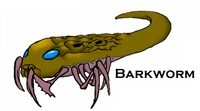
Barkworms are omnivorous insectoids that make their homes inside burrows carved out of tree-trunks. They are found wherever there are trees, and so are most common in the regions of the Northern Wildwood and the Equatorial Jungles.
Barkworms are a creatures that has changed very little in millions of years. They inhabit the inside of trees, helping to clean out dead bark and rotten roots, the way cleaner fish pick dead skin off larger fish on Earth. The Barkworms will also not hesitate to eat deceased animals either, provided they are not far from the creature's burrows (such burrows are either bored into the tree itself or are in the dirt beneath its roots).
Barkworms are about the size of a human hand.
Beach Crab (Spearfishing Crab)
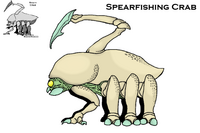
The Spearfishing Crab, sometimes shortened to just Spearfisher, is a terrestrial crustacean, that, as its name implies, eats mainly small fish that it catches with the brutal "hook" atop its back. It is found along the the warm, sunny coasts and beaches of the Meadowed Plains and the Equatorial Jungles.
(More description to be added at a later date.)
Blind Burrowing Snake
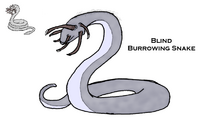
Blind Burrowing Snakes are subterranean mammals with an omnivorous diet (roots as well as insects). They are found in the following regions: Meadowed Plains, Equatorial Jungles, & the Northern Wildwood.
Due to a random mutation deep in its past, the Blind Burrowing Snake lost its eyes, to be replaced with short digging arms, each possesed of a single thick "fingernail"-like structure.
These creatures give birth to live young, about 2-4, and upon emergence, sniff out their mothers teats, and survive on a diet of milk until about 3 months, after which their mother weans them onto insects and roots.
The snakes live in small family groups, consisting of around 10-20 individuals and live in an extensive warren, not unlike Earth's prarie dogs.
In terms of size, Blind Burrowing Snakes are around the length and thickness of a human arm.
Bloat, Land (Gardenback)
This creature was named by the fans/players, as FortuneHost couldn't think of a decent one when it was submitted.
(Description to be added at a later date)
Bloat, Sea (Rainbow Blimpie)
(Description to be added at a later date.)
Bloat Whale

(Description to be added at a later date.)
Chomper, Bull

Bull Chompers are terrestrial herbivorous repto-mammals that live in the high tops of mountains and other alpine environments. As such, they are only found in the Mountains region on Fortune.
Gorilla-sized mountain herbivores, the Bull Chomper is an offshoot of the "Thumbed Chomper". Developing in the mountains, the Bull Chompers fur became thicker, shaggier, and turned a deep black. This colour change served to absorb more of what little heat it recieved high in its alpine home. Surprisingly, it also serves as camoflauge. Bull Chompers will bury their bodies in the snow, and look for all the world (to hungry predators at least) like a rock formation jutting out of the snow.
Bulls Chompers travel in herds of about 5-10, a single alpha male and his "harem" and children, like lion prides on Earth. An alpha male possesses a bright red "mohawk" a symbol of his status, but one that only develops once a male has a herd of his own (similar to the change that turns male gorillas into silverbacks).
Most young males will wander alone, never to be seen save during mating season. It is during this time that the alphas are formally challenged (with headbutting reminiscent of musk oxen) , though sometimes while fighting, other males will sneak in and mate with the females, who have no qualms 'cheating' on their alpha. Any products of these unions are allowed to hatch, but as soon as the young can walk, the alpha will chase it from the herd. Bull Chompers, like most of Fortune (save for the Arctic Serpents & Blind Burrowing Snakes) lays clutches of eggs. One hallmark of the various Chomper species is that they lay only a few eggs (one or two at a time) and then raise them to adulthood.
The Bull Chomper possesses thick calluses on the ends of its knuckles, these serve as dextrous "hooves" that assist the creature in staying steady on high mountaintops much like Earth mountain goats.
Chomper, Camleback
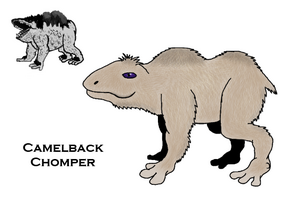
Camelback Chompers are terrestrial repto-mammals found in temperate to dry plains & steppes as well as deserts. They subsist on a herbivorous diet and are found in the regions of the Great Northern Savannah, the Desert, and the Meadowed Plains.
Camelback Chompers are horse-sized nomadic herbivores that are built to survive harsh, dry conditions. They mainly do this through the use of the fat cells stored in their "hump", allowing for them to, in emergency or drought, to survive for about 3 weeks without food, noticeably shrinking their humps. Should this happen, the Camelback will gorge at the next opportunity, attempting to replace the lost storage. Their bodies are also adept at storing water, including thick jowls (like a Bloodhounds) that trap saliva in the cheeks, allowing it to be reused rather than lost via drool/evaporation.
Camelbacks travel in herds of anwhere from a dozen to nearly a hundred animals, grazing and lazily migrating across their habitats. These herds are the primary family unit, and while hatchlings are cared for mainly by their biological parents, Camelbacks often have a group of older females past breeding age that act as a sort of "daycare" for the herd as a whole (similar to meerkats on Earth). Camelbacks even have the curious practice of "adoption", where, if the parents of a baby or juvenile Camelback perish, a mated pair without a child of their own will take the youngster in. At times this is done even if the mated pair already has a child, and other times one of the non-breeding "daycare" females will take the orphan in.
(Chomper) Smiler
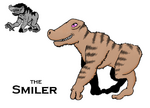
The Smiler, or Smiling Chomper is a herbivorous terrestrial repto-mammal that lives in forests or plains of almost any sub-arctic climate, being found in the Great Northern Savannah, the Meadowed Plains, and the Equatorial Jungles regions of Fortune.
The Smiler is a gorilla sized herbivore that travels in family groups not unlike Earth chimpanzees. The troop is led by a leading mated pair, and child-rearing is overseen by all females of the group. They are most at home in grasslands, but the species does well in forests too. Smilers are well known for their use of tools, unique on Fortune. They use the spikes of the Spineroot plant to dig up large roots and tubers as an alternative to their regular diet of grasses. It should be noted, though, that there is no sense of ingenuity or invention in this, and that it is almost purely instinct. For now, the Smiler's intelligence has plateaued.
Smilers get their names from the creepy looking grin that, because of their jaw structure and musculature, is permanently etched onto their faces.
Demolisher (Spineback)

(Description to be added at a later date.)
Featherscale
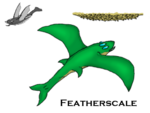
Featherscales are carnivorous fish native to warm-to-tropical waters of the Coastal Shallows and Western Ocean regions.
These wolf-sized predators are exclusively adapted for hunting Sea Bloats, to the point that *any* change in the Sea Bloat population has a corresponding and profound effect on Featherscale numbers.
The main hunting tactic of the Featherscale is to "wind-up" the muscles in their tail, putting all their energy into a tremendous burst of speed, and leaping out of the water. From their, the creatures glide for several minutes, attempting to spear any Sea Bloats with their mandibles. Eventually, though, the Featherscale must return to the water (as it does not possess lungs, only gills), and gravity takes its toll. Ideally, the creature will have snagged a Bloat, floating on the surface and ripe for the picking. If not, the creature will have to try again later, when it cathes its "breath".
Featherscales lay thousands of soft slimy-coated eggs in underwater caves disguised with sea-flora. The young hatch into small thumb-sized fry that must fend for themselves from the moment of birth. On average, only around 7% reach adulthood.
Grey Wretch

The Grey Wretch is a carnivorous terrestrial repto-mammal that makes its homes in Fortune's cold to temperate forests and plains, being found in the regions of the Mountains, the Northern Wildwood, and even the Arctic Circle.
Grey Wretches are grizzly bear-sized solitary predators of the north, though they are also sometimes seen in pairs. Interestingly, Grey Wretches (like their ancestors) only seek breeding partners near the very end of their lives (somewhere along the last few months or so), and when they spawn, their death soon follows (similar in this respect to Earth's salmon population).
The female lays up to a dozen or more football-sized eggs, burying them in a large pile of dirt or snow-drift. When the young hatch, they are about the size of a chihuaha, and stick together for safety, catching insects and other small prey, until they are old enough for larger game. Once they reach 60% of their adult size, the juvenile Wretches part, leading solitary lives, though by this point, there is rarely more than 5 of the original clutch left.
Ice Bug
(Picture and description to be added at a later date.)
Ice Ray
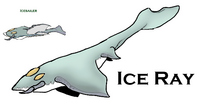
Ice Rays are carnivorous fish that make their homes in the arctic to temperate waters of the Western Ocean, North Sea and Continental Shelf regions, being found at Near-Surface to Mid-Range depths.
Ice Rays have flat manta-ray like bodies and hunt either solitarily or in a mated pair. They mate for life, and in fact, if one of the pair dies, the other will waste away, refusing to eat, seemingly mourning its lost partner.
Ice Rays are semi-nocturnal, occasionally hunting at night, where they come closer to the surface. Here, in the moonlight, at seemingly random intervals, they gracefully somersault and backflip in the water. These hauntingly beautiful "dances" are a complete mystery, and no one has any idea as to why they are performed.
Ice Rays are near the size of a dolphin, but almost 2-3 times as wide, owing to their "wingspan", the modified fins that 'flap' through the water, providing locomotion.
Piranha Fly
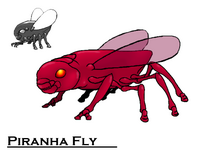
(Description to be added at a later date.)
Proboscis Scorpion
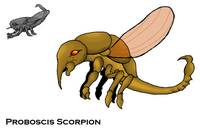
The Proboscis Scorpion is a herbivorous terrestrial insectoid inhabiting forested areas of the Meadowed Fields, the Equatorial Jungle and and Northern Savannah.
The scorpion is about the size of a human palm, and possesses wings rendering it capable of short bursts of flight, as well as a sharp ovipositor that's sharp enough that, in a pinch, can be used as a weapon.
Female scorpions will store fertilized eggs for extended periods of time, until they can use their stingers to inject hundreds of eggs under the skin of a larger creature, where the young hatch and develop.
They begin their life as carnivorous larval creatures consisting of little more than powerful jaws, and begin eating their host from the inside out. Most of the time this will kill the host, though in the case of larger creatures it may simply deliver irreparable damage. They develop into their adult forms while inside the host, the final stage being losing their jaws and developing a proboscis/tongue, upon which they will burst out of the host and find their way to the nearest Asparagus Tree, using their proboscis to feed upon the rich resin in the core of the tree.
Raveshark, Abyssal (Ravedragon)
(Picture and description to be added at a later date.)
Raveshark, Common (Midnight)
(Picture and description to be added at a later date.)
Raveshark, Shadow
(Picture and description to be added at a later date.)
Rock Slug

The Rock Slug is a filter feeding aquatic invertebrate with a complex lifecycle. It is primarily found in the Abyss region, where it serves as prey for many other species. Its adult form is a small, rocky-shelled creature that uses suction to slurp mud into one of the seven mouths on its underside. It also possess two very large tentacles whose primary purpose is mating, It also possess two very large tentacles whose primary purpose is mating, bearing the fertilized eggs and then the larval forms of its species.
The Rock Slug's next stage depends on being eaten by one of the many varieties of Raveshark. Once inside the predator's stomach, the mother is digested and the larval slugs are thus freed from the coral-like birthing chambers they formed on her tentacles. As medusae (singular, medusa), they spend some time as parasites; feeding on the Raveshark's intestines before being ejected into the sea.
Once back in the sea they find a place to settle down and form a tube-like polyp, extruding tentacles into the water and feeding until they grow large enough to strobilate into their adult form.
There is a segment of the Rock Slug population that possess toxin-generating cells (contained in their "tails"), which give the slug a sting attack not unlike Earth's jellyfish. These creatures are known as Stinger Slugs. Stinger Slugs look identical to their non-stinging kin, and other than their toxin production, they are no different that Rock Slugs. Indeed, they are the same species. Stinger Slugs result if the mother of a brood of larvae is eaten specifically by a Ravedragon. It is then, during their time as medusae in the dragon's intestine, these larvae will steal the some of the fish's toxin cells to use for stings of their own once they are ejected and mature into adults.
There are many varieties of Rock Slug or slug-dervied creatures (referred to tenatively as Slugiformes) living all over the ocean, covering every depth range. Some maintain their original parasitic lifestyle, latching onto other animals to feed on their blood (like Earth leeches). Some of them are filter feeders. A few of them prey upon other slugs, using beak-like structures to crack open tough shells. A rare few of them (the jellyfish-like Stinger which lacks a solid slug-form, for example) maintain stinging cells in their tentacles or cilia.
Most of them have simple life-cycles, going from fertilized egg into a tiny version of their full-grown parents. Others utilize varying forms of the slug/medusa/polyp life cycle, providing the ocean with a range of shellfish, sessile filter feeders, parasites, and jellyfish-like organisms.
Stingers
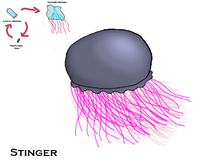
The Stinger is a strange, jellyfish-like creature common to all ocean regions, and is common from deep to sea-floor depths.
Stingers are entirely dependent on the Ravesharks for the propagation of their species. At the beginning of their life-cycle, they float in the sea covered in a tough shell as fertilized eggs, only hatching once ingested by a Ravedragon. Once hatched into voracious little medusae, they feed greedily on the Ravedragon's intestinal tract as well as any partially-digested food they can find within, all the while constantly spewing gametes behind them. This results in a spray of fertilized eggs and Stingers the next time the Raveshark defecates. Being ejected in this manner marks the end of the Stinger's medusae phase. Now free-floating in the ocean, the Stingers balloon up into large filter-feeding free-floating jellyfish. Unlike other species, Stingers actually lose the ability to reproduce as they age (rather than gaining the ability with maturation) They do not mate again, living a pointless existence until eaten by some other animal.
Stingers, as evinced by some similarities in their life-cycle (the presence of a parasitic medusae phase as well as the need to be eaten by a Raveshark) are actually close relatives of the Rock Slugs, having split off from their "parent's" genus near the end of the Ice Age. Another trait shared with its cousin is the segment of poisonous individuals within the larger species. If ingested by the specific species of Raveshark called Ravedragons, the medusae will steal some of the creature's toxin cells "on the way out" granting the adult-form stinging tentacles of its own.
Sail Flipper (Windsail Dolphin)

The Windsail Dolphin is a carnivorous fish native to the temperate to tropical waters of the Continental Shelf and the Southeastern Ocean, and can be found in Near-Surface to Mid-Range depths.
The Windsail Dolphin uses its large fins to be blown around by the wind, conserving energy by letting the breeze and tides carry them. Windsails are about as big as their dolphin namesakes, and have a similar diet, mostly small fish.
Why the sails developed is unknown, but the features get plenty of use during the semi-annual migration of the species, travelling from one end of the planet to the other. For a few years, the species lives in the tropics of the Continental Shelf, slowly moving southwards, until, 3-5 years later, they near the edge of the region and begin migrating towards the more temperate waters of the south-end of the Southeastern Ocean, gradually moving north, from whence they will return to the northern Continental Shelf.
This long process is in place to avoid "overfishing" an area, gradually moving once food hits a certain low, and returning many years later when prey populations have recovered.
Saltback Frog

The Saltbacked Frog, or simply Saltback is a terrestrial amphibian that dines almost exclusively on the Salt Cactus, a plant that, despite its name, grows on the banks of freshwater bodies in warm to tropical areas as well as swamps and wetlands of a similar climate. Thus it is that the Saltback dwells here also, being native to the Equatorial Jungles region of planet Fortune.
While the creature has lost its shell since evolving from the Shellfog, the Saltback does retain a decoration of sorts, an assortment of salt crystals adorning its back (hence the name). This is the result of the creature's body filtering out the high sodium content of its diet, too much of which will dry the Saltback out like a slug. As the frog matures, it forms a hard "shell", while astonishing to look at, it does not provide any sort of protection. Said display, is, however sometimes used in courting rituals, as a thick crust of the stuff indicates the individual is well fed, and thus both healthy and smart enough to stay alive by avoiding predators.
Saltbacks are small, the biggest are around the size of an outstretched palm. That said, these small critters are a prolific bunch, not to mention loud. During the mating season (anywhere from late spring to midsummer), males and females will croak to each other, and within these chirps and ribbits, the health, size, age, and gender of the frog making them is made apparent (to other Saltbacks, anyway).
When a frog hears a mate that it likes, it will follow the sound to the caller and try to initiate the courtship dance. If the other accepts, they will mate and lay a foamy mass of around 700 of eggs. The pair will then separate, not to see each other again, except perhaps next season. The young are but miniature version of the adults, unlike Earth frogs, though they do breathe through gills at this stage, eventually, these gills will be replaced with lungs as the young mature.
Shogun Walrus

Walrus-sized slime/jelly creatures native to the Meadowed Plains, Great Northern Savannah and the Arctic Circle, the Shogun Walrus is a strange dirt-eating, acid spitting oddity. It has two stomach cavities, one of which leads up to its "nostrils", which are in fact tubes through which virulent stomach acids may be fired at predators. That said, the walruses don't have too many enemies, as they taste terrible and they're bodies are highly acidic, especially near the nostril cavities (from where they fire their attack) and the tail (where their mouth is located).
The Shogun Walrus reproduces via fission. An individual grows in ever-so-slightly in size when it eats, and when it reaches a certain critical mass, it splits into two creatures, the original and a smaller, hairless verison. This newborn will gain its long coat of fur as it matures into adulthood.
Skullroot
The Skullroots are a bipedal species native to the Equatorial Junlgles of strange design. They are a parasitic organism that re-purposes both the Asparagus Tree seedling and reproduction methods to further its own kind. Spending its entire life within the resin packet of the tree, it gorges upon the resin and grows alongside with the infant tree it's attached to, forming a body that will be used once expelled from its macabre cradle.
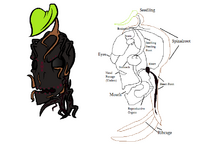
Within each clutch is born a single female and thousands upon thousands of male "Tadseeds" with well-developed infrared eyes, the Tadseeds are attracted to the female's bright red markings and enter into their "mouths" and into the reproductive organs to be used in the future, in this sense the males are nothing more than glorified sperm packets that will only live if they find and are accepted by the female. Their bodies are incorporated into the females, until nothing but the gonads are left upon the reproductive organs inner linings (this is similar to some species of anglerfish on Earth).
Inside the resin these fertilized females begin to grow a "skeleton" of roots, later covering it with thin gray skin that covers from the thick "hair" roots, to the ribs, and two-toed feet. During the development of the skeleton the important organs of the Skullroot leave the skull through an opening in the back and position themselves with the ribcage, specifically the heart which then begin to grow resin veins over the rest of the body, and the stomach which stores mass amounts of resin to be tapped upon when the body leaves the tree. The reproductive organs expand into the rest of the skull, leaving little room for the brain, which stays small.
Once they leave the resin packets a Skullroot has a limited amount of time before they die, starved for resin. While the creature does have internal stores of resin, this is pumped through "veins", and enables locomotion, until it runs out, of course.
The armless creature wanders slowly, far beyond the mother tree, expelling the seeds of Skullroot-infested Asparagus Trees from her mouth all the while. Due to the mixtures of protein and plant materials from the resin, make a nutritious meal for many carnivores or omnivores, but if not eaten along the way, the mother eventually perishes. Once the resin in their veins is consumed by the process of locomotion, both by pumping through the body and then consuming it for the energy to do so, the Skullroot becomes immobile and starves, its task in (literally) sowing the seeds of the next generation complete.
Skullroot, Deathmasque
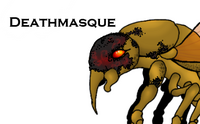
(Description to be added at a later date.)
Snow Beetle
(Picture and description to be added at a later date.)
Snow Crab

Snow Crabs are scavenging terrestrial crustaceans common in the Arctic Circle region, though they are occasionally seen in the upper reaches Northern Wildwood.
Snow Crabs are a reminder that evolution often moves slowly because, like your bum hippy cousin, it only works when absolutely neccesary. Snow Crabs evolved from Pretender Crabs, who would lure creatures in by pretending to be the plants their prey ate. The thing is, neither of the plants that Snow Crabs resemble even exist anymore, having moved on to other forms. The Snow Crabs, however, have been succesful enough that there has been little need to change their features, though it is possible that the "pretender stem" that is their species' legacy may eventually atrophy, or they may find use as a mating display. Only time will tell.
Snow Crabs live in colonies or "clutches" of 20-50 individuals, with singles, mated pairs, and offspring all present. There is no rank here, no alpha male or matriarch present. The reason Snow Crabs gather together is for warmth. While they are invertebrates, Snow Crabs are endothermic (what some call warm-blooded), and the body heat generated from close proximity helps keep hypothermia away as the creatures sleep under large snow drifts.
As previously mentioned, Snow Crabs are by and large scavengers, consuming those creatures who failed to survive in the cold land where the crabs make their home. There is little discrimination in what is consumed, and even a fallen clutchmate, a stillborn offspring, even a deceased mate will be devoured. Meat is meat, after all, and food is scarce.
Snow Tick
Despite their misleading name, Snow Ticks are terrestrial bloodsucking parasites common to every land habitat on Fortune.

The Snow Tick takes advantages of the many large animals in it's habitat, using it's sturdiness and strong claws to cling to their skin, while an adapted leg siphons blood from it's host. Wretches and the various Chomper species are their most common hosts. As it feeds, it grows bloated and ever so slightly more fragile as its skin stretches to accommodate the fluid within. Once full in this manner, the Snow Tick leaves its host, hibernating inside a tree hollow or under a rock until it hungers again.
Snow Ticks spend a great deal of their lives asleep. Long slumber (3-4 days) punctuated by gorging themselves on a host and the occasional mating (sometimes done on a host if that's where they meet) comprises the entirety of their lives. Gross to humans, from the viewpoint of the tick (if it had one as a nonsentient) life is good.
Different ecotypes of the Snow Tick tend to inhabit areas, exhibiting slightly different coloured carapaces. In time, these may diverge into new species, should different pressures affect the various populations.
Spitter Crab

Spitter Crabs are omnivorous, terrestrial crustaceans common to the Northern Savannah and Meadowed Plains regions. The vast majority of the crab's diet is vegetable matter, but every once in a while, the creatures will scavenge, dining on dead creatures. They have never been observed chasing or hunting prey, and it's likely they do not do so.
Spitter Crabs are not very large, being about the size of a laptop. They do, however have one ingenious defense, and that is their spit attack for which they are named. The Spitter Crabs possess a gland that produces a thin filmy fluid that is a powerful deterrent against predators, as once it comes into contact with exposed skin, it burns like pepper spray. Few enemies are determined enough to endure the pain long enough to strike. One creature that this spit has no effect on is the Spineback. Their armour is so extensive that their "flesh" never sees the light of day, and thus is never considered exposed. Thankfully for the Spitter Crab, though, for the most part they are too small to make a good meal for the massive apex predator.
Tentacle Leech

A horrifying blood-sucking parasite, the Tentacle Leech can be found wherever there are Ravesharks.
Tentacle Leeches evolved from a species of slug-like leech that attached to many aquatic species, especially the Ravesharks. After feeding on, and being eventually eaten by, their Raveshark hosts, a chance mutation making the leech's ancestors "taller" with longer tentacles proved to be a vital change for the species. While many of their cousins continued their normal way of life (and these eventually became the Slugiformes, see the entry for: Rock Slugs), the new, longer, taller leeches began infiltrating the Raveshark's tentacles, latching on to them at their base, gorging on blood until the tentacle withers away, and then the leech takes its place, eventually fusing its body into the shark's as it uses its twin tentacles to feed the rave shark and its durable rocky shell to protect from its host's ravenous maw. The hosts appear either to not notice or not care about the replacement of a few tentacles in this manner.
The anonymous poster who created the Tentacle Leech has stated that this creature was inspired by a real-world parasite called the tongue louse (Link not recommended for the squeamish).
Webspinner (Silt Spinner)
(Picture and description to be added at a later date.)
Plants
Alpine Herb
The Alpine Herb is a common plant spread across Fortune's temperature regions. It can be found in the Great Northern Savannah, the Northern Wildwood, the Mountains, the very edges of the Desert, and especially throughout the Meadowed Plains. The above-ground portion of the plant is a crop of long and thin leaves, tinted yellow from the potent toxins leeched from a fungus the plant is symbiotic with. Just underground is a large bulb, from the bottom of which extends an extensive root system. Both the bulb and roots are entwined heavily with a nodule-forming fungus which extends fruiting bodies above ground in the warmest parts of the year.
The Alpine Herb reproduces both by going to seed, with its seeds resembling small grains that fall to the ground near the plant, and by budding off new "bulbs" from its root system as the plant expands.
Asparagus Tree, Common
(Picture and description to be added at a later date.)
Asparagus Tree, Steppes
(Picture and description to be added at a later date.)
Bloodsucker Lichen
(Picture and description to be added at a later date.)
Bluegrass, Common

(Description to be added at a later date.)
Bluegrass, Dwarf

(Description to be added at a later date.)
Boom Ginger
Boom Gingers are a combustible plant found mainly in the Meadowed Plains region, though they are also present in sparse numbers in the Savannah. Their explosive property is a feature of their method of dispersion, as the "boom" for which the herb is named spreads the seedlings far and wide (not unlike a cluster bomb).
(Picture and more description to be added at a later date.)
Ice Shrub
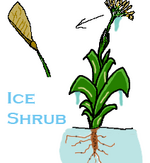
Ice Shrubs are small grassy shrubs common in the Arctic Circle. They reproduce in a manner similar to dandelions on Earth, having lightweight seedlings that are dispersed upon the winds.
Once common across much of the planet during the Ice Age, the Ice Shrub is now only seen in the far north. It's adaptations had little use once the world began to finally thaw, and it was beaten out in many areas by other varieties better adapted to this new world.
In the cold snows of the Arctic Circle, though, the Ice Shrub is king, a highly adapted species that excels where no other can. It is a change in biochemistry that is the source of such specialization, all to deal with the extreme temperatures that came about during the plant's prime in the Ice Age. It accomplished this by the secretion of several cold fighting chemicals, including a glycol-compound that combated the issue of frostburn.
Mud Shrub
(Picture and description to be added at a later date.)
Salt Cactus
Salt Cacti are plants native to the Equatorial Jungle regions and are found along the banks of bodies of freshwater, a habitat they share with the Saltbacks. Salt Cacti provide the main (almost sole) source of food for these frogs.
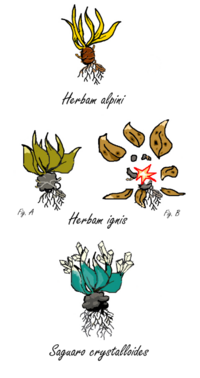
Salt Cacti take their name from the many spines covering their spongey stems and leaves. These sharp points are from sodium crystals, formed both naturally by the plant as well as being supplemented by minerals filtered out of the water that the plants drink.
Much of the freshwater in the Equatorial Jungles owes its lack of salinity to this plant. When the glaciers melted at the end of Fortune's Ice Age, the oceans rose quickly, turning much of the continent into swamp (like a freshwater version of Earth's Carboniferous Era). While these waters receded eventually, these left the land saturated with minerals, and for a time, little could grow in the area. Plants had a difficult (but not impossible) time growing. One plant had adapted to this, the Salt Ginger, the ancient ancestor of the Salt Cactus. With little competition, the Salt Ginger spread across what is now the Equatorial Jungles and the Meadowed Plains. As the species spread, they removed more and more minerals from the soil, rendering once poor soil into fertile land. The Salt Ginger's competitors took advantage of the newly fertile land, and pushed the plant back, settling into its current range. Nowadays it serves to keep the rivers and ponds of Fortune fresh, such that even a stagnant, runoff body similar to Earth's Dead Sea would be *almost* potable.
Snow Shrub
Snow Shrubs are small grassy shrubs found throughout the northern areas bordering the arctic circle, both in the Great Northern Savannah and the Northern Wildwood. They have a lightweight seedling which is carried and dispersed on the wind.
Unlike many plants it only truly comes to life during the winters in the north. Once the temperature drops, the Snow Shrub stirs to life, its dried and barely living stems turning green and lush in the cool. By the end of Winter it has bloomed and its seeds been dispersed, to lay fallow until the next Winter when they'll sprout.
Spineroot
(Picture and description to be added at a later date.)
Vampire Lily, Common
(Picture and description to be added at a later date.)
Vampire Lily, Flowering
(Picture and description to be added at a later date.)
Vampire Lily, Giant
(Picture and description to be added at a later date.)
Water Berry Groves
(Picture and description to be added at a later date.)